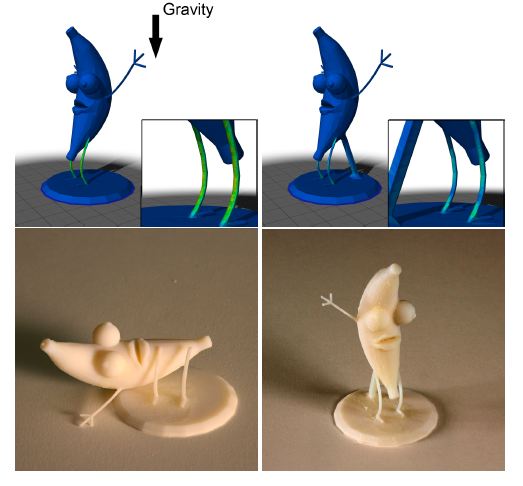New tool gives structural strength to 3D-printed objects
September 19, 2012

A banana model printed without optimizations is quite likely to break because of very thin legs. An optimized model with an added strut shows much more structural strength. (Credit: Ondrej Stava, Juraj Vanek, Bedrich Benes, Nathan Carr, Radomir Mech)
Researchers at Purdue and Adobe’s Advanced Technology Labs have jointly developed a program that automatically imparts strength to objects before they are printed.
Objects created using 3-D printing have a common flaw: They are fragile and often fall apart or lose their shape.
“I have an entire zoo of broken 3-D printed objects in my office,” said Bedrich Benes, an associate professor of computer graphics at Purdue University.
The printed fabrications often fail at points of high stress.
The 3-D printers create shapes layer-by-layer out of various materials, including metals and plastic polymers. Whereas industry has used 3-D printing in rapid prototyping for about 15 years, recent innovations have made the technology practical for broader applications, he said.
“It runs a structural analysis, finds the problematic part and then automatically picks one of the three possible solutions,” Benes said.
The software application automatically strengthens objects either by increasing the thickness of key structural elements or by adding struts. The tool also uses a third option, reducing the stress on structural elements by hollowing out overweight elements.
“We not only make the objects structurally better, but we also make them much more inexpensive,” Mech said. “We have demonstrated a weight and cost savings of 80 percent.”
The new tool automatically identifies “grip positions” where a person is likely to grasp the object. A “lightweight structural analysis solver” analyzes the object using a mesh-based simulation. It requires less computing power than traditional finite-element modeling tools, which are used in high-precision work such as designing jet engine turbine blades.
“The 3-D printing doesn’t have to be so precise, so we developed our own structural analysis program that doesn’t pay significant attention to really high precision,” Benes said.
Future research may focus on better understanding how structural strength is influenced by the layered nature of 3-D-printed objects. The researchers may also expand their algorithms to include printed models that have moving parts.